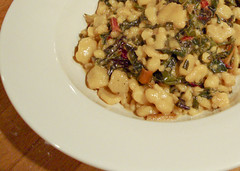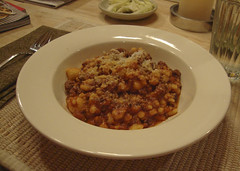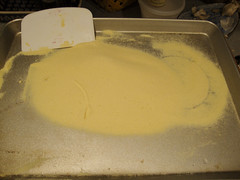 I love Italian food, especially pastas. When I find a new shape or technique, it's like a little gift. When I discover a method as easy as this one, but which produces such delicious pasta, it's like winning the lottery.
I love Italian food, especially pastas. When I find a new shape or technique, it's like a little gift. When I discover a method as easy as this one, but which produces such delicious pasta, it's like winning the lottery.I found frascatelli when I was looking for a carbonara recipe. I found this one on Food and Wine's website. The recipe is from
Michael Romano, executive chef of the Union Square Cafe. I didn't use the sauce recipe after all, but th
e pasta method was really intriguing. I looked a little more online and aside from a few more of Chef Romano's recipes, I found an article on the NY Times website. The NY Times article explains that the name comes from the word "frasca" which means branch in Italian.

Additional [limited] research suggested that this pasta may be Roman or Genoese. This is sort of like saying that a dish may come from San Antonio or Boston. I've got the Encyclopedia of Pasta on order and hope to learn more when that arrives. My gut says Roman, but I'm withholding judgement until I find corroboration. One web result suggests that this dish should be served to nursing mothers. I wonder if that's because this pasta is so easy to make that a nursing mother could fit its preparation into her busy schedule.
I sauced our frascatelli with a simple sauce of sauteed swiss chard, shallots, parmigiano reggiano and a tot of cream. Next time I'm going to try it with a ragu. The texture of the frascatelli is very potato gnocchi-esque, so use that to guide your sauce selection. I suggest the sauce be somewhat loose as the frascatelli will absorb liquid and become dumpling-like.

(edited to add picture of Frascatelli with Noney's Meat Sauce - delicious!)
Frascatelli
Serves 4 as a main course, to make more (or less), add about 1/3 cup (100 grams) of semolina flour for each person.
I strongly recommend you watch this video of Chef Romano making frascatelli: a movie is worth ten thousand words. He starts the frascatelli at about 3:10.
- 2 1/2 cups semolina flour
- cold water


Spread the semolina into an even 1/2" thick layer on a
baking sheet. Using your fingers, flick and drip cold water over the surface of the semolina. The semolina should look evenly polka-dotted. Take a dough scraper and lift and toss the semolina flour over itself: it will start to form small pebbles of pasta.
Lift the semolina into a strainer (over the baking sheet) and gently sift out the pebbles. Pour them onto a baking sheet which you have gently dusted with semolina or lined with a Silpat baking sheet. Continue to make the frascatelli: spread the semolina out again, sprinkle with water, strain. Continue doing this until all the semolina has been used up.
Once you get the hang of it, you'll find the process moves along pretty quickly. The trickiest thing is to get the drops of water about the same size. But as you can see from my pictures, my finished product had a range of sizing and they all cooked up just fine.

Once your frascatelli are done you can set them aside for later or cook them right away. If you are going to cook them later, dust them with a little more semolina and cover them with a dishtowel.
Before you cook the frascatelli, get your pasta sauce ready. You want your sauce to be warm and ready to go when the frascatelli are ready. Boil the frascatelli in salted water for about 3-7 minutes. Cooking time will depend on the size of your pasta pieces and how long you've let them wait before cooking. They are done when they are al dente but don't taste of raw flour. Drain the frascatelli, reserving some of the cooking water, and add them directly to the sauce. Add additional cooking water if things get too dry; the pasta can really soak up liquid.
If there are leftovers (unlikely), reheat them in a skillet over medium heat. Add a little extra liquid to keep things from sticking.



4 comments:
Ah-ha! I was wondering if I was going to see a blog post about this after you mentioned it on Twitter. :)
I have plans to make ragu bolognese once it gets a little colder - will have to keep this in mind for the pasta.
Do try it. Many things to recommend it: easy to make, versatile, and you'll wow your friends with your pasta know-how.
It is extremely interesting for me to read this blog. Thanx for it. I like such topics and anything connected to this matter. I definitely want to read a bit more soon.
It is rather interesting for me to read this post. Thanks for it. I like such topics and everything that is connected to them. I would like to read more on that blog soon.
Post a Comment